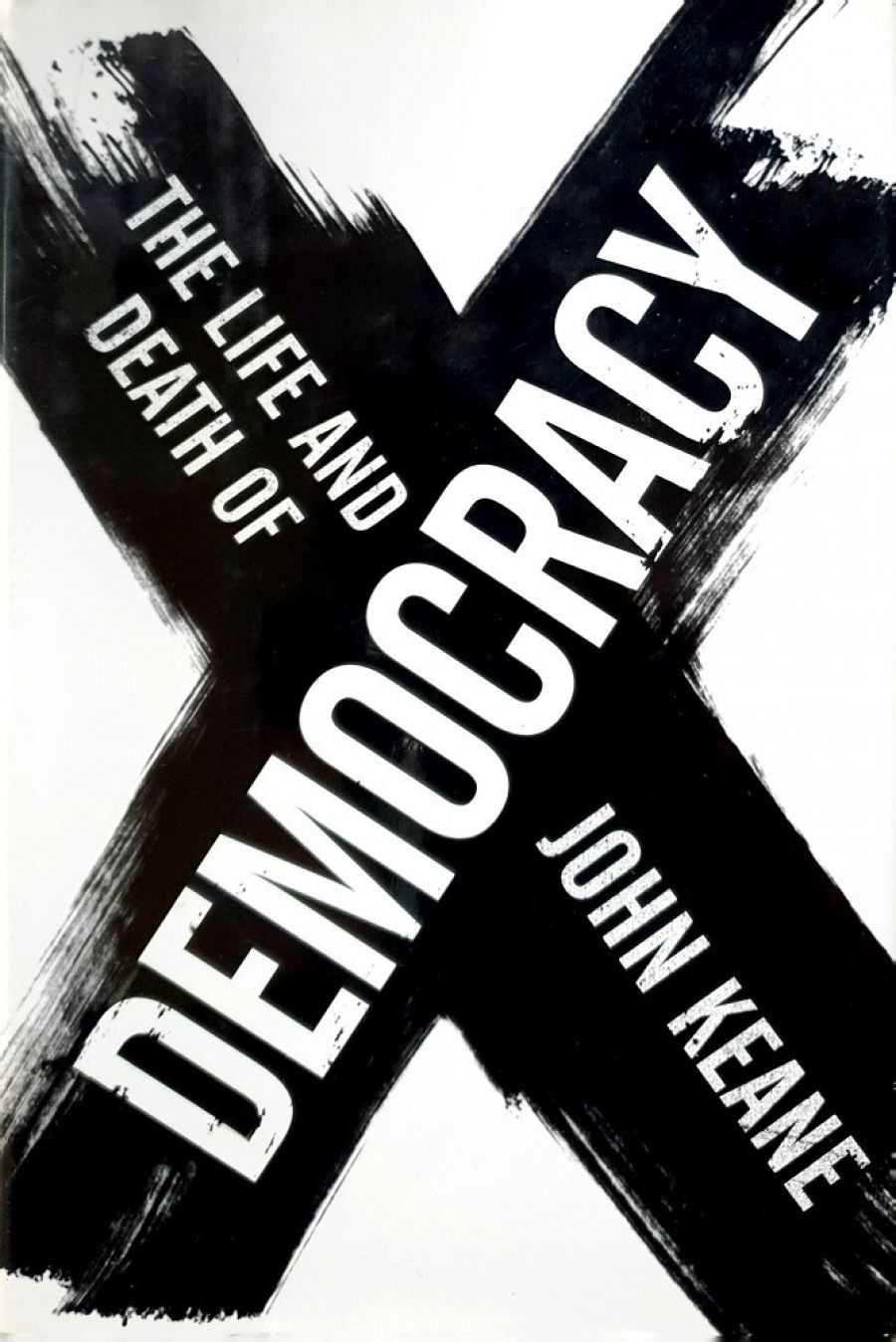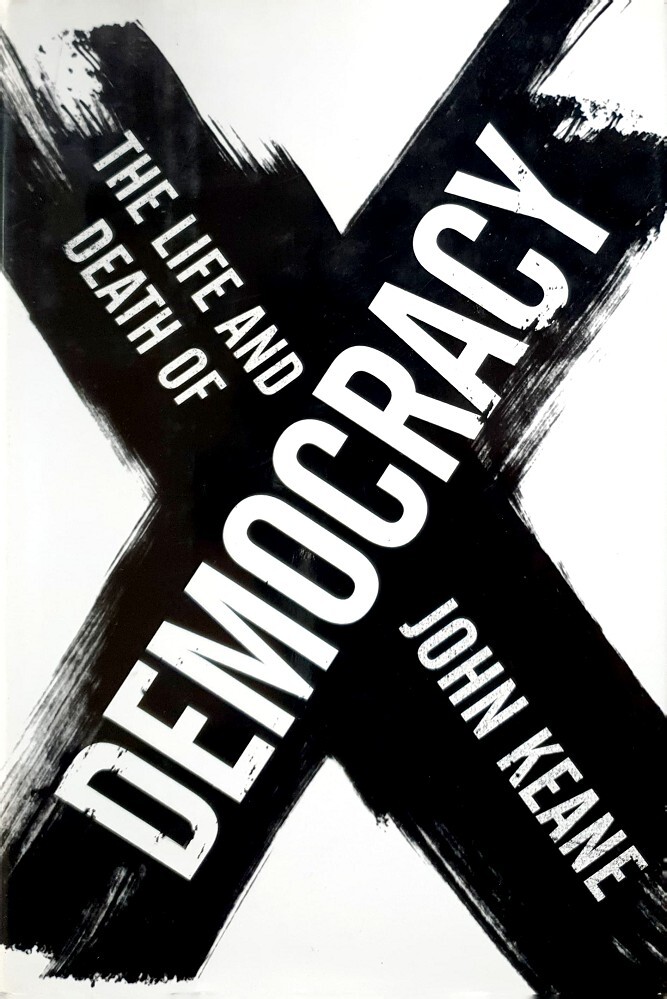
- Free Article: No
- Contents Category: Politics
- Review Article: Yes
- Article Title: Bad moons
- Article Subtitle: Emotive flaws in a new study of democracy
- Online Only: No
- Custom Highlight Text:
How does one review a serious academic study of 950 pages that covers two thousand years of political history? In this case I shall be upfront and declare that I am only reviewing part of Keane’s thesis, and will leave it to historians to discuss the remainder of his book. If I concentrate on the last 300 pages, this is because they contain more than enough material for even the keenest reader, let alone a harassed reviewer.
- Book 1 Title: The Life and Death of Democracy
- Book 1 Biblio: Simon & Schuster, $49.99 hb, 958 pp
- Book 1 Cover Small (400 x 600):

At least one distinguished reviewer has extolled Keane’s work in reassessing the history of democracy, which his publisher asserts is ‘the first grand history of democracy for well over a century’. I am not sure that this claim is justified, though Keane’s book is certainly longer and more universal than its competitors. Most political theorists would be content with that, but the most striking part of The Life and Death of Democracy is Keane’s suggestion that we have moved to a quite new paradigm. As he writes in typically overripe prose: ‘The new democracy demands a headshift, a break with conventional thinking, an almighty wrestle with words and meanings, in order to understand its political geography.’ ‘Monitory democracy’ is described as ‘a variety of “post-parliamentary” politics defined by the rapid growth of many different kinds of extra-parliamentary, power-scrutinising mechanisms’, and elsewhere typified as ‘a form of humble government, a way of creating space for dissenting minorities and leveling competition for power’.
Keane draws this concept from the work of the American political scientist Michael Schudson. In general he sees it as implying an extension of the democratic ethos into new arenas: ‘Every nook and cranny of power becomes the potential target of “publicity” and “public exposure”; monitory democracy threatens to expose the quiet discriminations and injustices that happen behind closed doors and in the world of everyday life.’ It was surprising that he ignores theorists such as Antonio Gramsci, Herbert Marcuse and Carole Pateman, all of whom have thought deeply about the ways in which power is exercised other than through the formal institutions of government. Nor does he seem interested in the large, and relevant, literature on ‘governmentality’ that has grown out of the work of Michel Foucault.
The stress on ‘monitory democracy’ is not surprising coming from someone who has already written at length on concepts of civil society. Keane has important and stimulating ideas about what this form means for genuine democracy, which, he insists, depends upon a recognition that humans construct power relationships and can constantly reshape them. For Keane, the true power of democracy is that it recognises contingency. He invokes the South African novelist Njabulo Ndebele to argue that democracy ‘pours cold water on karma’: that is, it allows people to recognise they can control their own destiny. He provides a range of examples of what he sees as new forms of democratic accountability, ranging from the Truth and Reconciliation Commission in South Africa to the rather odd example of the International Olympics Committee, which has cleaned up its practices as a result of media scrutiny but which is not, on his evidence, a model of any known form of democracy. In the same way, it is not clear why governmental summits are regarded as a move towards monitory democracy, though large popular global gatherings, such as the Beijing Women’s Conference or the International Social Forums, which he ignores, clearly are.
Social movements, as he stresses, often trump political parties in determining political agendas. This is undoubtedly true, but to speak of major movements such as the US civil rights movement or the anti-apartheid movement as equivalent to institutionalised forms of monitoring government performance seems to broaden the term so far that it becomes useless. Moreover, there seems no logic as to why Keane devotes many pages to the US movement while barely noticing the popular revolution that overthrew Marcos and that has been echoed by a range of popular political movements since. Keane seems to have a particular blind spot about the Philippines (oddly indexed as ‘Philippine Islands’); according to him, the United States has successfully ‘hothoused’ democracy there, which ignores the long struggle for Filipino independence after its conquest by Spain.
In the contemporary world, Keane suggests, there are constant innovations aimed at increasing and changing the nature of political participation. Thus the recent ALP federal conference might be seen as evidence of the collapse of the old Labor belief that its members actually influenced party policy. But here one might cite the increasing use of the Internet and the ability of electronic communications to mobilise opposition, even in authoritarian states such as Iran and China. Keane seems to have finished his manuscript before the election of Barack Obama, even though his campaign’s brilliant use of modern communications to mobilise large numbers of supporters is surely a sign of the potential vitality of representative democracy.
These examples might suggest that Keane is arguing that democracy is expanding, but the book is surprisingly pessimistic, with its warnings of ‘bad moons’, a term more fitting in rock music than in political analysis. There is a repeated warning that the enemies of democracy are increasing, although the evidence for this is slight (and while Keane has a lot to say about India, he says little about China, which in practice is now the major counter-example to both representative and monitory democracy).
The problem with Keane’s formulations is that he goes from hailing new moves for accountability and inclusion to expressing deep concern about what he sees as the diminution of representative government, as people lose faith in its traditional institutions, parties, elections and legislatures. Two years ago, he wrote of these shifts as leading to ‘a bowdlerization and degradation of democracy’, and identified John Howard’s Australia and Silvio Berlusconi’s Italy as prime offenders. In The Life and Death of Democracy, Thaksin Shinawatra is added as the third member of this particular axis. I can share a dislike of Howard, but the comparison with Italy and Thailand is absurd. Whatever his faults, Howard was not guilty of massive corruption; nor was he a major media magnate. Keane complains that such politicians ‘aim to win several elections in a row, so that the rules of the political game and the whole atmosphere of public life can be changed’. What, then, would be made of Robert Menzies and Franklin D. Roosevelt, whose electoral successes continued over longer periods?
Some of Keane’s ambivalence stems from his attempt to write at both a global and a national level; to evaluate the state of democracy within and beyond the nation state. While he points to the creation of a whole new paradigm of ‘monitory democracy’ within already representative systems, in less liberal societies he seems to want traditional liberal democratic advances, whatever their limitations.
Keane is graphic about the appalling behavior of which humans are capable, but it is not always clear how he relates this to his central story about democracy or, indeed, his knee-jerk anti-Americanism. The latter at times is contradictory, as when he recognises the United States both as a major proponent of democracy and its greatest enemy. Like many other European leftists, Keane seems equally outraged by the failure to intervene, as in Rwanda, and interventions of which he disapproves, such as the overthrowal of Saddam Hussein, and he fails to maintain a consistent position which might resolve the contradiction. Oddly for a historian with such a grand vision of change, the last part of the book is too marked by an emotional response to the presidency of George W. Bush, without much consciousness that Americans themselves might be about to embrace an alternative.
‘This book’s strategy of challenging humbug,’ writes Keane, ‘is deliberately strident’, which is indisputable, though I am less persuaded by his claim to write ‘with an even hand’. Writing in the Daily Telegraph, historian Noel Malcolm claimed that Keane’s view of democracy is that it succeeds when ‘power ends up being wielded by nice, right-thinking, liberal-minded people like himself’. I think this understates Keane’s interest in and commitment to genuine popular movements of the dispossessed which he discusses, especially those in India. But it is true that his overlong final section would have benefited from some of the humility he asserts is part of monitory democracy.


Comments powered by CComment